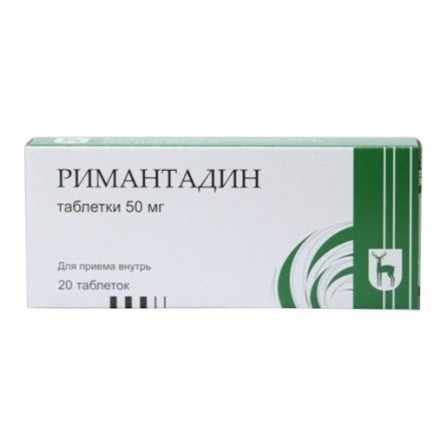Rimantadine pills 50 mg 20 pcs
Condition: New product
998 Items
Rating:
Be the first to write a review!

More info
Active ingredients
Rimantadine
Release form
Pills
Composition
Rimantadine hydrochloride 50 mg
Pharmacological effect
Antiviral agent derived from adamantane. The main mechanism of antiviral action is the inhibition of the early stage of specific reproduction after the virus enters the cell and prior to the initial transcription of RNA. Pharmacological efficacy is ensured by inhibiting the reproduction of the virus in the initial stage of the infection process. It is active against various strains of influenza A virus (especially type A2), as well as tick-borne encephalitis viruses (Central European and Russian spring-summer), which belong to the group of arboviruses of the Flaviviridae family.
Pharmacokinetics
After ingestion, it is slowly, almost completely absorbed in the intestine. Plasma protein binding is about 40%. Vd in adults - 17-25 l / kg, in children - 289 l. Concentration in nasal secretion is 50% higher than plasma. The value of Cmax when taking 100 mg 1 time / day - 181 ng / ml, 100 mg 2 times / day - 416 ng / ml. Metabolized in the liver. T1 / 2 - 24-36 h; excreted by the kidneys (15% - unchanged, 20% - as hydroxyl metabolites). With chronic renal failure, T1 / 2 increases by 2 times. In patients with renal insufficiency and in elderly people, it can accumulate in toxic concentrations, if the dose is not adjusted in proportion to the decrease in CC.
Indications
Prevention and early treatment of influenza in adults and children over 7 years old, prevention of influenza during epidemics in adults, prevention of tick-borne encephalitis of viral etiology.
Contraindications
Acute liver diseases, acute and chronic kidney diseases, thyrotoxicosis, pregnancy, children under 7 years old, hypersensitivity to rimantadine.
Use during pregnancy and lactation
Contraindicated in pregnancy.
Dosage and administration
Individual, depending on indications, age of the patient and the applied treatment regimen.
Side effects
On the part of the digestive system: epigastric pain, flatulence, increased bilirubin in the blood, dry mouth, anorexia, nausea, vomiting, gastralgia. From the side of the central nervous system: headache, insomnia, nervousness, dizziness, impaired concentration, drowsiness, anxiety, irritability, fatigue. Other: allergic reactions.
Overdose
Symptoms: agitation, hallucinations, arrhythmia. Treatment: gastric lavage, symptomatic therapy: activities to maintain vital functions.Rimantadine is partially excreted by hemodialysis.
Interaction with other drugs
With simultaneous use of rimantadine reduces the effectiveness of anti-epileptic drugs. Adsorbents, binders and coating agents reduce the absorption of rimantadine. Means, acidifying urine (ammonium chloride, ascorbic acid), reduce the effectiveness of rimantadine (due to increased kidney removal). Means alkalizing urine (acetazolamide, sodium bicarbonate) increase its effectiveness (reduced excretion by the kidneys). Paracetamol and acetylsalicylic acid reduce rimantadine Cmax by 11%. Cimetidine reduces the clearance of rimantadine by 18%.
special instructions
Rimantadine is used with caution in cases of arterial hypertension, epilepsy (including history), and atherosclerosis of cerebral vessels. When using rimantadine may exacerbate chronic comorbidities. Elderly patients with arterial hypertension increase the risk of hemorrhagic stroke. With indications of a history of epilepsy and anticonvulsant therapy, the risk of developing an epileptic seizure increases with the use of rimantadine. In such cases, rimantadine is used in a dose of up to 100 mg / day simultaneously with anticonvulsant therapy. With influenza B virus, rimantadine has an antitoxic effect. Prophylactic administration is effective in contacts with patients, in the spread of infection in closed collectives and at high risk of developing a disease during a flu epidemic. Perhaps the emergence of drug-resistant viruses.





